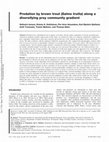Papers by Hallvard Jensen
Journal of Fish Biology, Mar 1, 2006
Ottar
Ressurser og arealer i utmarka blir stadig viktigere for samfunnet og er gjenstand for økende kon... more Ressurser og arealer i utmarka blir stadig viktigere for samfunnet og er gjenstand for økende konflikter, spesielt i nord. Samtidig kompliserer klimaendringer bildet ytterligere. NIBIO Tromsø forsker på en rekke fagområder relatert til ressursene i utmarka. Her presenteres smakebiter fra noe av dette arbeidet.
<p>Average (±SD) stable isotope values of the three fish species caught from different habi... more <p>Average (±SD) stable isotope values of the three fish species caught from different habitats in Lake Fyresvatn and their main dietary sources. Trout diet consists of fish (whitefish, charr and juvenile trout), benthic invertebrates and zooplankton. Diet of whitefish and charr consisted of profundal invertebrates, littoral invertebrates and zooplankton.</p
<p>Length distribution of a) whitefish, b) Arctic charr and c) trout in the survey gillnet ... more <p>Length distribution of a) whitefish, b) Arctic charr and c) trout in the survey gillnet catches in Lake Fyresvatn. Open bars show immature fish, and hatched and black bars matured males and 0females, respectively.</p
<p>Seasonal diet contribution ((%A<sub><i>i</i></sub>) of main prey... more <p>Seasonal diet contribution ((%A<sub><i>i</i></sub>) of main prey groups in the stomach contents of whitefish, Arctic charr and trout caught in littoral, profundal and pelagic habitats of Lake Fyresvatn.</p
<p>Density (CPUE) of trout, Arctic charr and whitefish in the three principal (littoral, pr... more <p>Density (CPUE) of trout, Arctic charr and whitefish in the three principal (littoral, profundal and pelagic) habitats throughout the ice-free season in Lake Fyresvatn.Throughout the season, trout was predominately caught in the littoral catches, the CPUE being highest in June (12.3) and almost equally levelled in August (7.8) and October (7.5). Trout was present in the profundal and pelagic catches, but the density was low (CPUE: 0.1–1.0).</p
<p>Significant values shown in bold.</p
Predation has a fundamental role in aquatic ecosystems, but the relative importance of factors go... more Predation has a fundamental role in aquatic ecosystems, but the relative importance of factors governing prey selection by predators remains controversial. In this study, we contrast five lakes of a subarctic watercourse to explore how prey community characteristics affect prey selection and growth of the top predator brown trout. The brown trout was a morph/species- and size-specific pelagic predator, selecting the small-sized, pelagic whitefish morph or vendace over the benthic whitefish morphs. In all lakes, the average prey size increased with predator size, but small-sized prey were also included in the diet of large predators. The selection of small-sized, pelagic prey fish appeared to be a favourable foraging strategy for the brown trout, yielding higher growth rates and an earlier ontogenetic shift to piscivory.
Fisheries Management and Ecology, 2015
Knowledge of predator-prey dynamics is essential to understand ecosystem functioning. Quantificat... more Knowledge of predator-prey dynamics is essential to understand ecosystem functioning. Quantification of such interactions is important for fisheries management, in particular in the case of stocking programmes. Here, food consumption rates (FCR) were quantified for wild and stocked piscivorous brown trout, Salmo trutta L., in three subarctic lakes with contrasting coregonid (Coregonus spp.) prey communities, using the Wisconsin and the Elliott-Hurley bioenergetic models. FCR was highest for stocked brown trout in lakes with the lowest predator densities, and lowest for wild brown trout. Although FCR estimate may vary somewhat depending on the specific model used, such tools are imperative for the proper impact assessment of brown trout stocking programmes and for the provision of advice on optimal stocking densities.
Journal of Fish Biology, 2012

Canadian Journal of Fisheries and Aquatic Sciences, 2008
Predation has a fundamental role in aquatic ecosystems, but the relative importance of factors go... more Predation has a fundamental role in aquatic ecosystems, but the relative importance of factors governing prey selection by predators remains controversial. In this study, we contrast five lakes of a subarctic watershed to explore how prey community characteristics affect prey selection and growth rate of the common top predator, brown trout ( Salmo trutta ). The lakes constitute a distinct gradient of different coregonid prey fish, ranging from monomorphic common whitefish ( Coregonus lavaretus ) to polymorphic whitefish co-occurring with vendace ( Coregonus albula ). The brown trout was a morph–species- and size-specific pelagic predator, selecting the small-sized, pelagic whitefish morph or vendace over the benthic whitefish morphs. In all lakes, the average prey size increased with predator size, but small-sized prey were also included in the diet of large predators. The selection of small-sized, pelagic prey fish appeared to be a favourable foraging strategy for the brown trout,...

Feeding ecology of piscivorous brown trout was studied in the Pasvik watercourse, Norway and Russ... more Feeding ecology of piscivorous brown trout was studied in the Pasvik watercourse, Norway and Russia. The watercourse is heavily regulated for hydroelectric purposes, and 5000 brown trout > 25 cm are stocked annually to compensate the negative impacts of the impoundments. Stocked and wild trout had almost identical diets consisting mainly of vendace Coregonus albula and partly of whitefish Coregonus lavaretus. Vendace has recently invaded the watercourse, and totally dominated the brown trout diet in the upstream part, where it has become the dominant species in the pelagic habitat. In the downstream part, where vendace were less prevalent, whitefish contributed to a larger extent to the trout diet. No correlation between predator (brown trout) and prey (vendace) lengths was found in the upstream part, and only a weak positive correlation was found in the downstream part. The length of whitefish eaten by brown trout, in contrast, showed a positive correlation with predator length ...











Uploads
Papers by Hallvard Jensen